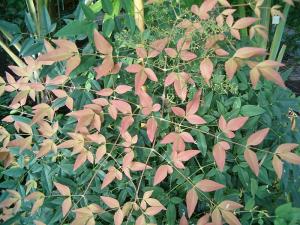Nandina

Weakness, loss of coordination, seizures, coma, respiratory failure, hyperventilation, dyspnea (shortness of breath) tremors, bright or brick red mucous membranes, and possibly death (rare in pets). Indicative traits of cyanide poisoning include cherry-red blood and mucous membranes, and for those that can detect it, the smell of bitter almonds is also very characteristic.
Cyanogenic glycosides are a natural plant self defense mechanism found in a percentage of ferns and higher plant species designed to harm or dissuade animals from eating them. These are amino acid derived compounds linked to a glucose molecule and stored as an inactive toxin in specialized subunits within the plant cells, called vacoule. When animals damage plant leaves these enclosed cellular compartments release cyanogenic glucosides which then come into contact with enzymes in the plant called ?-glucosidases. This removes the glucose molecule leaving cyanohydrin; a chemically unstable amino acid derived compound that will further degrade spontaneously or by the action of an hydroxynitrile lyase to produce toxic hydrogen cyanide gas (HCN).
Hydrogen cyanide (HCN) is a highly toxic volatile compound that interferes with the cellular respiration by inhibiting the cytochrome oxidase enzyme in mitochondria. This prevents the production of ATP (adenosine-5'-triphosphate), the molecule that transfers energy in the cell. Luckily plant related cyanide poisoning in pets is extremely uncommon as the bitter taste of cyanogenic glucosides tend to limit the amount of plant that the pet can tolerate consuming. Of the 3000 species of plant known to produce cyanogenic glucosides the most common ones that pets come into contact with are pitted fruits such as peaches, cherries and almonds; pome fruits such as apples and pears; legumes such as clover and vetch; elderberry; and a variety of grasses. Of these the greatest risk would be posed by the pits or seeds of pitted or pome fruits which a pet may ingest out of curiosity leading to a rapid ingestion of a toxic dose.
Due to the limited amount that pets are likely to consume, cyanide intoxication is rare and usually produces more of a gastrointestinal disturbance than a life threatening situation; In cases where the pet has consumed a toxic amount the prognosis is poor to grave as death can occur in minutes. This means most pets will die before their owners are aware of the condition and before treatment can be instituted. On a more positive note, treatment is, in most cases highly effective so long as the pet is still alive and the heart is still beating; even in the event that respiratory arrest has occurred.
Prevent Further Ingestion of the Plant, Seek Veterinary Treatment, administer cyanide antidotes as soon as possible, without delay for tests to confirm red blood cell (RBC) cyanide levels. In recent ingestions consider gastric lavage followed by the administration of activated charcoal. It should be noted that the gastric aspirate may cause secondary contamination and should be viewed as hazardous. Treat patients with 100% oxygen.
CYANIDE ANTIDOTAL COMPOUNDS IN USE
Antidote / (Route of Administration): Sodium nitrite (IV), sodium thiosulfate (IV), 4-Dimethylaminophenol (IV or IM), Dicobalt edetate (IV) and Hydroxocobalamin (IV)




